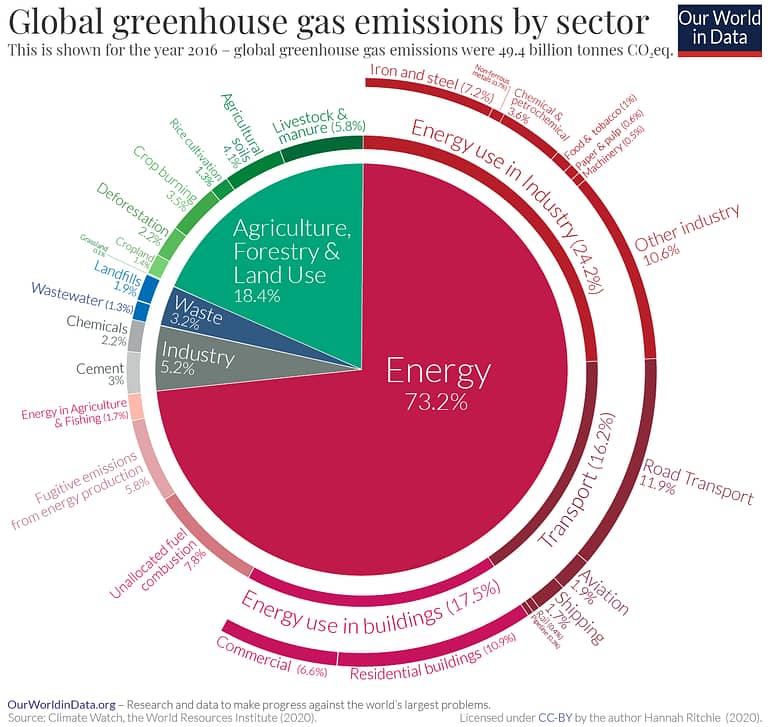By Rob Atkinson | Senior Project Manager
Earth Day 2023 is happening at a critical moment—as society comes to terms with human activity as the cause of CO2 levels adversely impacting the planet’s climate and ecosystems. The key to solving this problem and avoiding temperature increases and extreme weather lies in reducing those levels, which means eliminating dependency on industries that add carbon to the atmosphere and finding ways to reduce the excess carbon already there. Last year, the United Nations’ Intergovernmental Panel on Climate Change report spelled out the task pretty clearly, “Greenhouse gas emissions must peak by 2025 and reduce by 43% by 2030,” only seven short years away.
Getting there and still providing for all our needs will be an enormous effort for everyone from individuals to small and large businesses to governments (even fossil fuel companies). The problem appears complex, inspiring exploitation, including the greenwashing by corporations that proclaim empty commitments and are more focused on ensuring quick profits, as some propose unreasonable solutions such as depopulating communities or colonizing other planets. None of this gets us any closer to a solution and only generates a sense of climate despair or disengagement.
Can we transition to new ways of providing for our needs so that the future closely resembles or improves our current lifestyle? Yes, but only by engaging directly with implementable solutions and confronting climate change head-on. And this presupposes that everyone participates in the creation of solutions—including you and me.
But despite what you may think, a lot has already been achieved. In the US, the Inflation Reduction Act passed in 2022 allowed for billions of dollars in tax credits for clean energy and low carbon technologies over the next decade. And in the EU this year, a green deal industrial plan was unveiled which includes a net zero industry act and other measures aimed at incentivizing and fast-tracking clean energy projects across the bloc. In 2022, wind and solar power produced more of the EU’s electricity than fossil fuels for the first time. A total that is only going to increase as the EU distances itself from cheap, alternative oil and gas distributors.
What Is Coming
Expect to see even bigger changes in 2023. The COP28 agenda will drive the shift from previous years’ pledges to concrete action, working collectively with stakeholders to create solutions across mitigation, adaptation, loss and damage, and climate finance. EU countries will be pushing for the global phaseout of fossil fuels. Significantly, COP28 will be hosted in the United Arab Emirates (UAE), the world’s sixth-largest oil producer. Even the UAE energy minister is talking about the practicalities of phasing out the oil and gas industries.
The energy sector is also noting the impact of record-high energy prices on economies still recovering from the pandemic. The sharp escalation of power generation costs is causing a rapid rise in inflation, prompting the International Energy Agency in its 2023 Electricity Market Report to urge that 90% of new electricity demands between now and 2025 be covered by clean energy options such as wind, solar, and nuclear sources. Their rationale is sound—if the affordability of energy continues to be a challenge for emerging and developing economies, the global economy can no longer tolerate energy sources held hostage by unstable regimes.
But what about the vague sustainability commitments of some corporations and businesses? How can we be sure they genuinely play their part? Well, the EU’s green deal, introduced in January 2023, includes more stringent, legally-binding requirements for larger companies designed to reduce the adverse effects their operations have on the environment including those of their supply chains. Meanwhile in the US, the Securities and Exchange Commission is currently proposing rules to enhance and standardize climate-related disclosures for investors. This includes information about climate-related risks and a business’ greenhouse gas emissions.
Many global investors are now prioritizing funds compliant with Environmental, Social, and Governance (ESG) investing principles, which means corporate responsibility claims are increasingly coming under scrutiny. Investment research firms that provide critical decision-making tools and services for the global investment community are tightening up the criteria that qualify ESG-compliant funds, which is intended to directly address the unsubstantiated claims of corporate greenwashing as well as controversies surrounding offsets. Hundreds of funds could be stripped of their ESG ratings, and thousands more will be downgraded unless companies credibly commit to getting serious about realizing their ESG priorities.
Reliable Measurable Standards
Additionally, real measurable standards are now emerging. In June 2023, the IFRS (International Financial Reporting Standards Foundation), a non-profit organization that oversees financial reporting standard-setting, is due to publish the first global climate reporting standards. At last, there will be a metric for assessing governance of climate-related risks designed to measure the carbon output of companies’ operations and exactly how they intend to plan for climate transition beyond vague long-term promises.
Outside the US and EU, the International Organization for Standardization, an independent, non-governmental international organization with a membership of 168 national standards bodies, has developed a net-zero tool for policy makers and all who work towards net-zero-greenhouse-gas emissions for their business, group, or country, including China, Brazil, and Russia. This will address actionable guidance on getting to net zero as soon as possible, including transparent communication, credible claims, and consistent reporting on emissions, reductions, and removals. The gaps in compliance among governments and business leaders are closing fast, and that will have positive benefits for the environment and humanity at large.
Energy as a Challenge
One of the greatest challenges is energy itself. Currently, 89% of emissions come from fossil fuels, which supply 80% of the world’s energy needs. Emissions are split between industry energy use in buildings (heating and cooling), and transport. Government legislation is focusing on the first two by transforming systems towards sustainable energy sources, but all of us can play a part by electrifying everything from our cars to our homes and offices. And we can pressure utility providers to ensure that the fuel resources powering those changes come from sources free of carbon emissions. When utilities go to non-emitting sources, we become equal participants in positive change. Even climate deniers have difficulty arguing against clean energy sources that do not adversely impact their monthly bills, even more so when those costs decrease.
Change by Design
All this directly impacts consumer product design. We have seen the efficiency of LED lights and EV cars once implemented. Improving the design of consumer goods to facilitate energy efficiency, zero waste, and low carbon (through takeback schemes and circular design principles) will still allow for the selling and buying of huge quantities of products without a cost to the planet.
When we start promoting products based on their efficiency, reliability, and reusability rather than their green credentials we can prevent the hoarding and landfill created by mountains of obsolescent technology and slowly-deteriorating chemicals and materials.
For architects and designers, the biggest challenge is in how to rapidly decarbonise. Some changes particularly in the manufacture of textiles, furniture, and finishes can be achieved through a commitment to specifying sustainable materials, changing processes to be more energy efficient, or the use of low-carbon energy sources. This is already happening within the construction industry through Environmental Product Declarations (EPDs), which support carbon emission reductions, allowing designers to compare the impacts of different materials and select the most sustainable options. And this also benefits manufacturers since they are able to optimise the impact of their products and market their carbon transparency.
Conclusion
All the changes proposed here have carbon reduction as their baseline. If we can reduce our carbon to pre-industrial levels, we can avoid runaway climate change and create a real future that does not involve dramatic lifestyle changes.
In many ways, designers are in the driver’s seat of change. With a focus on expanding sustainability commitments, this change becomes easier to enact every day. We have better information to specify the low and carbon-free products we want on projects. We already have the support of manufacturers who are working hard towards supplying products that meet the same goal, as well as a construction industry constantly innovating to build more sustainably. We can contribute to positive change individually, but the solution involves all of us—together!
Rob Atkinson | Senior Project Manager
With over 25 years of design experience, over 15 of which have been in leadership roles, Rob Atkinson simultaneously occupies the roles of Lead Designer, Senior Project Manager and Sustainability Consultant across a broad range of industry sectors. These include a specific focus on workplace, financial, infrastructure, and life sciences projects. He collaborates with senior stakeholders and leads creative and technical teams globally across Europe, the Middle East, and Africa.




